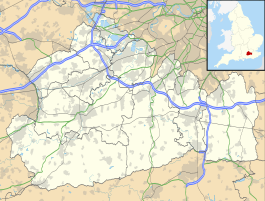Horley railway station
| Horley | |
|---|---|
 | |
| Location | Horley |
| Local authority | Reigate and Banstead |
| Grid reference | TQ286426 |
| Managed by | Southern |
| Station code(s) | HOR |
| DfT category | D |
| Number of platforms | 4 |
| Accessible | Yes[1] |
| Fare zone | D |
| National Rail annual entry and exit | |
| 2019–20 | |
| 2020–21 | |
| 2021–22 | |
| 2022–23 | |
| 2023–24 | |
| Key dates | |
| 1841 | first station opened |
| 31 December 1905 | resited |
| Other information | |
| External links | |
| Coordinates | 51°10′08″N 0°09′40″W / 51.169°N 0.161°W |


Horley railway station serves the town of Horley in Surrey, England. It is on the Brighton Main Line, 25 miles 60 chains (41.4 km) down the line from London Bridge via Redhill, and train services are provided by Thameslink and Southern.
There are 4 platforms, all 270 yards (247 m) long, capable of accepting 12-car-long trains.[3]
History
The present Horley station is in fact the second in the town. The original station, constructed by the London and Brighton Railway, opened on 12 July 1841, was located 301 yards (275 m) north of the present site, where the Factory Shop is.[4] The first station was designed by David Mocatta and was on a larger scale than other intermediate stations on the line. Horley was situated almost midway between London and Brighton, and was chosen for the erection of the London and Brighton Railway carriage sheds and repair workshops. These were later moved to Brighton railway works. The station was enlarged in 1862 by addition of a second storey to the building. A canopy and footbridge were added in 1884.[5]
The current Horley station opened 31 December 1905, to coincide with the quadrupling of the railway line by the London Brighton and South Coast Railway. The original station then became the Station Master's house and survived until the 1960s.[6]
In the 1870s William Stroudley considered moving the locomotive works to Horley but was persuaded to keep them in Brighton. Nevertheless, the sidings at Horley were used for storing withdrawn locomotives and those awaiting repair until the First World War.
The Thameslink Programme turned over some of the Southern services over to the expanded Thameslink network currently operated by Govia Thameslink Railway. This project saw most services that previously terminated at London Bridge continuing through the Thameslink core in Central London and northwards via the Midland Main Line and East Coast Main Line to destinations such as Bedford and Peterborough.[7][8]
Facilities
- Concourse
- Ticket Office (1 Window)
- Quick Ticket
- Café
- Waiting Room (x2)
- Telephone
- Toilet (Unisex)
- Car Park (x2)
Services
Off-peak, all services at Horley are operated by Thameslink using Class 700 EMUs.
The typical off-peak service in trains per hour is:[9]
- 2 tph to Bedford via London Bridge
- 2 tph to Peterborough
- 2 tph to Three Bridges
- 2 tph to Horsham
During the peak hours, the station is served by an additional half-hourly Southern between London Victoria and Three Bridges. In addition, faster peak hour services towards Littlehampton now stop at the station.
During the night, the station is served by an hourly Thameslink service between Three Bridges and Bedford (not calling at London Bridge). This service runs on Sunday-Friday nights with an hourly Southern service to London Victoria on Saturday nights.
Although the station is outside Greater London, Oyster Pay as you go and contactless payment cards are valid. However, the station is outside the London Fare Zone area and as a result, special fares apply.
| Preceding station | Following station | |||
|---|---|---|---|---|
| Salfords or Redhill | Thameslink |
Gatwick Airport | ||
| Salfords or East Croydon | Southern
|
| ||
References
- ^ "Horley (HOR)". National Rail Enquiries. Archived from the original on 23 August 2017. Retrieved 23 August 2017.
- ^ a b c d e "Estimates of station usage". Rail statistics. Office of Rail Regulation. Please note: Some methodology may vary year on year.
- ^ "Rules Of The Plan" (PDF). Network Rail. 2007. Retrieved 12 June 2007.
- ^ Butt, R.V.J. (1995). The Directory of Railway Stations, Patrick Stephens Ltd, Sparkford, ISBN 1-85260-508-1, p. 123.
- ^ Minnis, John (1999). The London Brighton and South Coast railway, Tempus, ISBN 0-7524-1626-X, pp.19-20.
- ^ Howard Turner, J.T. (1979), The London Brighton and South Coast Railway. 3. Completion and Maturity, Batsford, London, ISBN 0-7134-1389-1, p. 152.
- ^ "Thameslink Programme (Thameslink 2000)". Transport for London. 2007. Retrieved 12 June 2007.
- ^ "Thameslink Programme". Network Rail. 2007. Retrieved 12 June 2007.
- ^ Table 183 National Rail timetable, May 2022
External links
- Train times and station information for Horley railway station from National Rail


